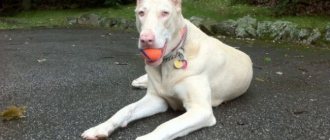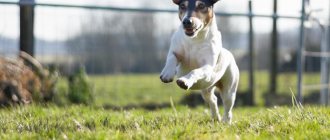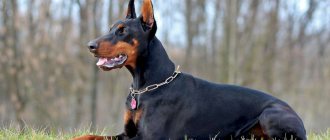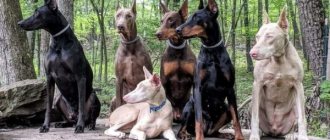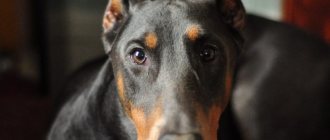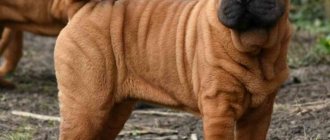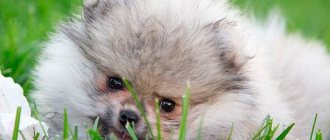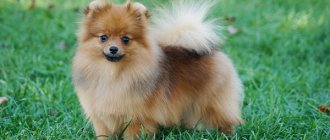Dogs, throughout their entire history of existence, were considered excellent guards, good defenders, and simply loyal friends. Recently, many breeds have changed a lot. We may not recognize a species known to us due to its unusual size or unusual color. An example would be the white Doberman.
Do you know the history of the appearance of the Doberman breed? Do you know about the existence of a white Doberman? If not yet, be sure to read the article.
According to standard
According to the breed standard adopted by the FCI, only two color variations of the Doberman Pinscher are allowed:
- Black and tan with clearly demarcated tan markings.
- Dark brown and tan.
In this case, the scorch marks should not be located in a chaotic order. The standard clearly defines their correct location. Doberman dogs should have tan on the face, above the eyebrows, on the neck, on the chest, on the underside of the paws, on the inside of the thighs, under the tail and on the ischial tuberosities.
The standard does not allow darkening or lightening of tan, the presence of white marks, or tan in any other places except those listed above.
Diseases
Doberman diseases are caused by genetic defects. A healthy dog can live up to 16 years. The owner's task is to regularly take the pet to the veterinarian. The dog may be diagnosed with:
- Allergy to dust, pollen, which can even cause ulcers on the skin.
- Diseases of the cardiovascular system: tachycardia, arrhythmia, heart failure, coronary heart disease. If your dog has difficulty breathing, problems with balance, or even falls when walking, then you should show it to the veterinarian; these may be symptoms of heart disease.
- Diseases that are hereditary in nature. Among them is gastric volvulus, which is characteristic of all dogs with a wide chest. Poor nutrition can only provoke the problem. If this disease occurs, the Doberman begins to behave nervously, he experiences bloating and salivation, vomiting, and pain in the abdominal area.
- Narcolepsy, which is accompanied by sleep disturbances and a decrease in muscle tone after active walks or outdoor games.
Choosing a nickname
For Dobermans, nicknames should be chosen based on their appearance. These are beautiful, intelligent dogs that are often recruited to serve in the army or police. The Doberman makes a wonderful protector.
The following names are suitable for boys of this breed:
- Emphasizing their strength and physical development: Atlas, Opal, Sunset, Zeus, Pharaoh, Caesar, Hercules, Achilles, Vulcan, Ararat, Sultan, Conan, Gloom, Circassian, Titan, Sherkhan, Elbrus;
- Nicknames that focus on color: Chocolate, Walnut, Ash, Black, Coal, Amber, Yakhont, Truffle;
- Nicknames that echo German names: Albert, Hans, Askold, Karl, Oscar, Jan, Nicholas, Rudolf, Theodor, Schultz, Richard, Jurgen, Max, Michael, Jurgen;
- Nicknames that emphasize the qualities of temperament (after all, how many dogs have so many characters): Rogue, Golden, Friend, Wind, Tango, Cyclone, Miracle, Glorious, Frisky, Fakir, Fire, Mars, Leader, Success, Hurricane, Champion, Romeo, Pilot, Indigo, Storm, Bulldog.
The following nicknames are suitable for girls of the Doberman breed:
- The most aristocratic nicknames that will emphasize the elegant, beautiful and graceful appearance of your dog: Hera, Ariadne, Star, Melisa, Roxy, Liana, Venus, Diva, Bagheera, Aelita, Naomi, Shelly, Stephanie, Yasmin, Aurora, Giselle, Luna, Paula, Camellia.
- To emphasize the temperament of your pet, give the following nicknames: Aida, Love, Verona, Gloria, Clear, Audrey, Oda, Blizzard, Fun, Muse, Night, Sonata, Melody, Doll, Prima, Fairy, Fortune, Charade, Ethiopian, Riddle, Rocket.
White
White color in dogs is associated with the albinism gene and is quite rare. Outwardly, these dogs look original: their white or light cream coat is combined with blue eyes that are unusual for the breed and a pink or flesh-colored nose. In the recent past, white dogs of this breed were considered rare and highly valued. But later it was found that the absence of pigment in them may be genetically associated with a number of diseases and pathologies.
For example, among white Dobermans there are animals suffering from congenital deafness or vision problems. In addition, they are too sensitive to ultraviolet radiation and have weaker immunity than colored dogs.
White albino Dobermans are characterized by unpredictability of behavior, increased nervousness, and sometimes cowardice.
It is believed that they are less suitable for service use than dogs of other colors, since they are not very healthy and often have mental problems.
Health
White Dobermans are more prone to illness than their brown or black counterparts.
Albino Doberman Pinscher is susceptible to various diseases
Commonly diagnosed diseases include:
- Cancer;
- Granuloma;
- Congenital deafness;
- Volvulus;
- Diabetes;
- Wobbler syndrome;
- Lipoma;
- Thyroid disease;
- Spinal disc disease;
- Cardiomyopathy;
- Alopecia;
- Chronic hepatitis;
- Skin diseases;
- Photophobia;
- Vision problems;
- Dermatitis;
- Baldness;
- Hip dysplasia;
- Lameness;
- Problems with blood clotting;
Vaccination schedule
| 7 – 8 weeks | Plague, adenovirus, parvovirus, parainfluenza type two, leptospirosis in dogs |
| 12 – 13 weeks | Full revaccination plus rabies vaccination |
| 1 year | Full revaccination |
| Further | Revaccination once a year |
Think carefully before purchasing a white puppy. Such dogs require much more care than their counterparts of the usual color. You will have to put up with both the psyche of your new pet and the peculiarity of his character. It should be taken into account that white Dobermans often get sick and need constant care and affection.
How to choose?
It should be remembered that it will not be possible to find a blue Doberman with documents of origin in Russia. This means that the future owner of such a pet will have to either buy a puppy without registration, or go to a foreign kennel to get the dog.
IMPORTANT!
Buying a puppy without documents is always fraught with the risk that the baby may have health problems or an unstable psyche.
If the decision to adopt a dog of this particular color is finally made, then you need to try to find a baby from dogs that have medical certificates.
When choosing a future pet, you need to give preference to a baby who does not show signs of cowardice or, conversely, aggression.
Selection of puppies
Choosing the right puppies is the key to getting a strong and healthy animal. Experienced dog breeders recommend purchasing from professional breeders who can show the puppy’s passport and immunization card. Equally important are the conditions of keeping the young animals, as well as their diet. Even minimal deviations from the norms should alert buyers, and perhaps completely prevent them from purchasing a puppy from unscrupulous sellers. It is strictly forbidden to buy albinos in spontaneous and unauthorized markets.
Having made the final decision to purchase, you need to make every effort to create comfortable living conditions for an unusual dog.
Experts note the high price of white Dobermans and the difficulty of acquiring them. Many breeders consider this breed a defect and do not register newborn puppies. Beginning dog breeders should take into account the following feature of young dogs – the absence or invisibility of genetic defects, which will become bright and noticeable with age.
Signs of healthy young animals:
- dark eyeballs;
- Long neck;
- long and powerful body with a square shape.
Crooked paws and the presence of light spots are unacceptable deviations from the standard. Professional dog handlers recommend paying attention to the following uncharacteristic features:
- small height;
- limbs are too large;
- presence of long hair;
- the shape of the body is far from square;
- incomplete set of teeth;
- weak bone skeleton;
- incorrectly set ears (high or low);
- arched or convex spine;
- the presence of clubfoot and lameness;
- the presence of a bevel in the croup area.
For puppies up to 45 days old, breeders must dock their tails and, if desired, their ears. Experts do not recommend performing these manipulations in adulthood. The immunization card for three-month-old puppies should contain information about vaccinations against the following diseases:
- leptospirosis;
- plague;
- adenovirus;
- parvovirus;
- viral gout;
- parvovirus infection.
Vaccination must be carried out regularly every 12 months.
The decision to purchase an unusual animal should be based not on emotions, but on common sense. A gentle and sensitive pet needs special care, timely medical attention and constant behavioral adjustments. Beginning dog breeders must understand that they are fully responsible for the life and health of their pet. If you don’t have complete confidence in your abilities and the ability to raise a healthy and obedient dog, then you need to abandon this idea.
Is it worth buying a white Dobermann puppy?
In order not to jeopardize the gene pool of the breed as a whole, it is not recommended to breed Dobermans with blue or Isabella colors.
Blue and Isabella
These colors were once considered standard, but later dogs with this coat color were excluded from breeding. This was primarily due to the fact that the weakened black gene makes animals of blue or isabella color predisposed to diseases such as dermatitis, allergies and demodicosis. In addition, animals with lightened colors often have low immunity. Because of this, they are more susceptible to infections.
Not all breeders have abandoned their breeding, since the unusual appearance and rarity of such dogs currently make blue and Isabella Dobermans a real exclusive.
The blue color can vary from silver-gray to dark lead. It has reddish or reddish markings.
The Isabella coat color of representatives of this breed can be described as beige-blue. Often a pinkish or lilac tint is also noticeable. Tan is also present, but may be lighter than the standard black and tan or brown and tan colors.
Inheritance of Doberman Pinscher Coat Colors
The inheritance of basic coat colors (that is, whether a Doberman will be black, red, blue or fawn) was described in 1865 using a simple genetic method by the monk Gregor Mendel. The results of his experiments on flowers were published in a little-known journal. It was only many years later that scientists and breeders, but not the public, realized that his methods were also applicable to animal breeding. This explains why, as early as 1963, there were publications claiming that the fawn and possibly blue color of Dobermans was the result of a genetic “weakening” caused by certain types of inbreeding. It was only before the adoption of a new breed standard in 1969 that most Doberman breeders recognized that color inheritance obeys simple Mendelian laws.
The principles on which color inheritance is based are:
1) each dog has at least two pairs of genes responsible for color;
2) each parent passes on half of the genetic material stored in this pair to the offspring;
3) there are dominant and recessive genes.
In other words, each parent carries its own pair of genes, which are responsible, for example, for color, and the set of genes that carry all the information about the body is called a genotype - the genetic characteristic of a dog. If one of a pair of genes suppresses the action of the other (that is, is dominant in relation to it), then it is its action, for example, color, that will appear in the offspring, while the second will remain hidden from view (suppressed, or recessive). The term "phenotype" refers to the revealed expression of the genotype. Simply put, the genotype is the traits hidden from view that can appear in the offspring, and the phenotype is the traits that appear externally.
The color of the Doberman is determined genetically. First of all, let's look at the main colors - black and red, then - undiminished (black and red) and weakened, or dilute (blue and fawn), and then their combinations.
Black color (B - black) is dominant in relation to red (b - brown).
The pairs of genes responsible for the manifestation of the trait and designated by letters consist of the father's gene and the mother's gene. A capital letter indicates a suppressor gene, that is, a dominant one, and a lowercase letter indicates a suppressed one, or recessive one. The diagram shows that the gene for black color is dominant in relation to red. Therefore, for a dog to have a red color, it must have the bb genotype, that is, it must be homozygous for a recessive trait, otherwise the gene will not be able to manifest itself. A genotype consisting of a pair of identical genes, that is, responsible for the manifestation of the same trait, for example BB or bb, is called homozygous, and a genotype consisting of different genes, for example BB, is called heterozygous.
Six possible crosses between these three genotypically different dogs. For this we need a combination square, or R.K. lattice. Penneta, which is a square, on one side of which all types of female gametes are written, and on the other - male ones. Inside the cells, all the resulting genotypes of zygotes (offspring) are recorded.
Do not forget that the examples given are based on the theory of relativity, and in life these relationships may turn out to be different if a number of additional factors are not taken into account.
The same scheme can be painted for blue and deer dogs, with the only difference that to the genotypes of black or red colors one should add an allelic pair of attenuating genes that is homozygous for a recessive trait, that is, dd (dilution). The weakening gene can be dominant - D, then it does not manifest itself, and recessive - d, but manifests itself in a homozygous state.
By painting the Punnett grid, you will receive identical splits by genotype and phenotype, and by considering all four colors, you will get nine genotypes and four phenotypes (described in the breed standard). Below the numbers is the color code of the American Doberman Pinscher Club for a given genotype (they published a table of colors containing this list, as well as the percentage of phenotypes obtained by studying 81 of their combinations that can be obtained in the club).
We recommend reading: Weimaraner - dog breed
Considering that the zygote will receive only one of the genes of the allelic pair of each parent and the independent distribution of non-allelic genes, each puppy will receive only gene B or b, D or d.
Please note that the ratio of normal colors (black and red) to weakened ones is also 12:4 or 3:1, as is the ratio of black to red colors.
Caring for an Albino
If the goal is to get a loving pet, assistant and faithful family friend, then you should not separate the dog from yourself. You should not trust the advice of keeping a Doberman in an outdoor enclosure, especially an albino. In an apartment, dogs feel just great. Smooth and short hair without much shedding does not cause trouble for owners.
The main thing to do with a Doberman is to provide him with physical activity on a daily basis, in addition, do not leave the dog alone for a long time. If all family members work and there is no one in the house all day, you can make a Doberman friend in the form of another dog, they will become good companions. In this case, the dogs will simply have no time to be bored.
Important! It is necessary to walk with the animal daily for at least 2 hours. These athletic dogs need to be given exercise along with a walk, as they are very athletic and energetic.
As for wool, it needs to be cleaned with a special brush or mitten once a week. You can simply wipe the dog with a damp cloth, which is also an effective cleaning.
You should bathe your dog only if necessary, as the coat becomes dirty. You can only wash your paws after a walk every day. To clean fur when bathing, you should use only special products from pet stores. Human soaps and shampoos are not suitable for Dobermans or any other dog.
Additionally, it is necessary to trim the claws when they grow up. In the summer you don’t have to do this, they wear off well on the asphalt, but in the winter the procedure needs to be carried out several times a month.
Keeping a Miniature Pinscher at Home
The miniature breed is quite easy to keep, clean and does not require special coat care. However, it is highly advisable to follow some important rules that will make the life of a pet of this breed comfortable and long.
Care and hygiene
The short coat of the miniature pinscher or miniature pinscher does not require too frequent or vigorous brushing. This breed does not create problems during the shedding period, but once a week it is advisable to brush the coat with a brush with not too coarse bristles.
If correct and timely ear cropping has been performed, then a healthy dog rarely needs to have its ears cleaned, so standard care comes down to weekly preventive examinations.
Uncropped or semi-drop ears will require more attention. It is also necessary to systematically trim the dog’s nails, which rarely wear down naturally while walking outside.
Increased attention must be paid to the miniature pinscher's mouth and teeth, since tartar often becomes a very serious problem that requires qualified medical intervention. The best option is weekly prevention in the form of brushing your teeth.
What to feed your miniature pinscher
The composition of the diet of a miniature pinscher is not too different from the rules for feeding dogs of other breeds:
- the amount of meat is at least one third of the total daily volume of other food products. For this purpose, it is allowed to use lean beef, rabbit and poultry meat;
- the amount of plant food is about ¼ of the total daily diet. The best vegetable crops are carrots, zucchini, beets and cabbage, which can be given either raw or stewed, with the addition of a small amount of any vegetable oil;
- the amount of cereals is approximately a third of the total volume of daily feed. It is recommended to use oatmeal, rice and buckwheat porridge.
About a couple of times a week you need to replace meat products with boneless fillets of any low-fat sea fish.
Dry ready-made diets of high quality are the most convenient to use and are well suited for feeding a miniature pinscher, regardless of age.
Such food is perfectly preserved for a long time, it is convenient to take them on the road, and among other things, the composition of the finished diet is completely balanced
It is important to remember that you should not mix canned food or dry diet with natural products.
Diseases and breed defects
The most common shortcomings and disqualifying defects of the miniature pinscher are:
- coarse or overly light build;
- short or high legs;
- heavy or rounded skull;
- folding on the forehead;
- short, pointed or narrow muzzle;
- direct bite;
- light, too small or too large eyes;
- low-set or very long ears;
- ears with different types of set;
- the presence of a dewlap;
- an excessively long, tight or soft back, as well as a hunchback;
- sloping croup;
- ambling or prancing step;
- rare wool.
A dog of this breed should not be cowardly, aggressive, angry or nervous, and should not have an underbite or underbite, or misalignment of the jaw. The most common hereditary and breed diseases of the miniature pinscher include:
- urolithiasis disease;
- tracheal collapse;
- diabetes;
- shoulder dislocation;
- Legg-Calvé-Perthes disease
- pannus;
- progressive degeneration of the retina;
- dystrophy of the ocular cornea;
- entropion of the eyelid;
- glaucoma and cataracts;
- epileptic seizures;
- congenital deafness.
Polytrauma, which develops when the pet falls from a great height, is quite common in miniature pinschers. Among other things, the miniature pinscher must be protected from cold and drafts, and to maintain health, it is necessary to provide the pet with systematic preventive veterinary examinations, timely vaccination, as well as long walks with outdoor games.
All black
True black Dobermans are almost never found. Dogs that appear black usually just have very dark tan that blends in with the base coat color. Dobermans without tan marks are recognized as a breeding marriage based on color. They are not allowed to participate in exhibitions or for breeding.
It is extremely rare, but Dobermans still have a true black color. It is presumably an atavism that they inherited from the Great Danes.
Description
The white Doberman Pinscher is a partial or incomplete albino with blue eyes. Selection work on breeding this species began in the mid-19th century, the goal of which was to obtain hardy, intelligent and disciplined dogs for police work. The first puppies were obtained only two decades later from parents of a standard color. Inbreeding did not bring a fixed result, but only a partial one.
The appearance of such an unusual color is due to the fact that the gene responsible for the white color of the animal’s coat is not located together with the diluting and color genes, but in a different place in the chromosome. And the two above-mentioned DNA sections are precisely responsible for the formation of one of the main four colors of Dobermans.
The white Doberman is a strong and at the same time elegant animal with a developed muscular system and a protruding chest. The skull has a triangular elongated shape, with small oval eyeballs located on it. Protruding ears can be either cropped or intact. The jaw has a scissor bite and strong white teeth.
The long and strong neck smoothly transitions into a small back. In all newborn puppies, breeders almost completely dock the tail immediately after birth. The muscular limbs are long and parallel. The average height of an adult is 75 cm and weight is 50 kg.
The average life expectancy of a white Doberman is 7 years, but by creating comfortable living conditions, choosing the right menu and balancing physical activity, the animal will be able to please its owners for more than 10 years.
Distinctive character traits:
- indecision;
- lack of quick response;
- cowardice;
- inadequacy;
- nervousness;
- developed sense of ownership;
- devotion.
These character traits must be taken into account during training and training of animals.
The Doberman must constantly feel the attention of its owner and understand his superiority. The animal will only obey commands from a strong and persistent owner.
All demands must be stated firmly and confidently, but without aggression, cruelty, beatings or rudeness. After a correctly completed task, it is advisable to reward your pet with a tasty treat.
The genetic makeup of white Dobermans makes them vulnerable to the following diseases:
- fear of light;
- chronic eye and hearing diseases;
- oncology and various types of tumors;
- diseases of the endocrine system;
- lipoma;
- diseases of the digestive system;
- hepatitis;
- allergy;
- hair loss;
- von Willebrand disease;
- diseases of the circulatory system;
- diseases of the musculoskeletal system and joints;
- skin rashes and irritations.
Like any pet, the white Doberman has a number of advantages and disadvantages.
Advantages:
- beautiful appearance;
- devotion.
Flaws:
- high susceptibility to various diseases;
- weak nervous system;
- poor perception of commands.
Brown
Second suit recognized by the FCI. Brown or, as it is also called, red color somewhat softens the harsh appearance of the Doberman and visually enlarges it.
Dogs that are the color of dark chocolate and have bright tan look the most impressive. The eyes of an animal of this color should also be brown, but a lighter shade is allowed. Another nuance of this color is that it can fade in the sun. Otherwise, brown dogs are no different from black and tan dogs.
Final thoughts
While researching and writing this article, I used information from scientific, official and even unofficial sources. This included phone calls and numerous conversations with experienced breeders of alternative colors.
Information that appeared to be generally agreed upon by both parties is included in this article. The main points of disagreement were left to the discretion of the “White Doberman Controversy” section.
This article was intended to introduce others to the White Doberman who may not have heard of this dog before, and to help them decide for themselves whether breeding and owning these dogs is moral. Although I have tried to remain as unbiased as possible, many people have asked me what I think about cream-colored Dobermans (or white Dobermans).
Although I firmly believe that once a Doberman of any type is born, he deserves the same love and care as any other Doberman. I don't have a strong opinion on whether these dogs should be bred at all, as I think both sides make valid arguments. That's why this is one of those topics that I'll leave to you, my readers, to decide.
Spotted
Infrequently, you can also see a Doberman of black or brown color, which has white spots of various sizes and shapes scattered on the main background. There are also Dobermans, whose color is surprisingly similar to the color of the coat of Great Danes or Dalmatians. On a white background there are small colored markings, usually brown or black. With this color, tan may be present, located in the places provided for by the standard.
Spotted Dobermans are a breeding match whether they have a tan or not. White markings of any size on these dogs are absolutely not allowed by the standard.
Possible defects
The ideal Doberman is a dog with a square shape. If we talk about the disadvantages, they include:
- high legs;
- sparse fur with long hair;
- completely white color or white spots;
- weak bones;
- aggressiveness;
- close-set ears;
- clubfoot;
- very sloping croup.
The back of such a dog can be hunchbacked, which not only spoils the appearance, but also causes discomfort to the animal. There are individuals who are too timid, which is not typical for the breed.
Disqualifying faults
The white Doberman will not be allowed to participate in international exhibitions, since albinism is a complex and harmful mutation of the dog’s entire body, and not just an unusual coat color. White color is a clear reason for disqualification. The International Organization of Cynologists does not recognize such dogs.
Lifespan: how many years does he live?
If you provide the animal with good care, its average life expectancy (from 7 to 10 years) can increase to 15 years. The white Doberman is a dog whose health can hardly be called strong.
Smiling dogs
When you mention a smiling dog, interest and many questions immediately arise: is this possible?
In fact, your four-legged friend cannot smile by nature, but there are several factors that make pets smile. Firstly, it is imitation of your cheerful and smiling owner, who shows interest in the dog. Secondly, the pet still tries to show love to its owner, and it can do this through a kind of smile.
You can tell if your pet is really smiling with these signs:
- His upper lip is raised, but he does not growl, but grins.
- The dog wags its tail, expressing joy.
- If, on top of everything else, he snorts or sneezes, there is no doubt – the pet is smiling at you.
There are several breeds that are able to show cordiality and smile:
- Dalmatian;
- Staffordshire Terrier;
- Yorkshire Terrier;
- Samoyed husky;
- welsh corgi;
- Golden retriever;
- Spitz
These breeds are quite famous on the Internet and simply from the lips of dog lovers. A smile flashes on the faces of these breeds more often than on others. For example, the retriever is quite famous for its face, on which a smile shines almost constantly. Perhaps she was never even seen without a smile.
The Welsh Corgi and Spitz breeds are famous all over the Internet thanks to videos of them smiling. These dogs show patience and cordiality towards their owners; their loud barking often fills the house, but this barking does not speak of the pet’s anger, but of its tireless desire to play and enjoy life.
Animals that smile are very popular, because in a world where there are so many troubles and misfortunes, a person is not always able to find something bright and pleasant, something that will make you smile. But here she is, a dog, your best four-legged friend, jumping out of the room and even giving a peculiar smile and joy in her glowing eyes.
Albinism gene
17. About 1 in 70 people are carriers of the albinism gene. If both parents have the albinism gene, there is a 25 percent chance of having a child with albinism.
18. For an albino child to be born, he must have faulty genes from both parents. If a child inherits one normal gene and one albinism gene, the normal genes will produce enough melanin.
19. One of the most serious types of albinism is known as Hermansky-Pudlak syndrome.
. People with this disorder are prone to bleeding, bruising, and lung problems.
20. Vitiligo
is another skin disorder associated with albinism, in which only certain areas of the skin lose pigment. Famous people with vitiligo: Michael Jackson and model Winnie Harlow.
21. Albinism is most common among various peoples in central and western Africa. Some evolutionary biologists believe that when we transitioned from primates to hominids and lost most of our hair, the skin underneath the hair was pale. People who produced more melanin (those with dark skin) were thought to have an evolutionary advantage.
22. Scientists can test whether parents have the gene for albinism by looking at whether the hair follicle produces melanin.
23. Some people in eastern Africa, especially Tanzania, which has the largest population of people with albinism in Africa, believe that an albino child is born to mothers who cheated with a white man, or that the child is the ghost of European colonists.
24. There is currently no treatment that will cause your body to produce melanin and reduce the symptoms of albinism.
Red
This color can be described as reddish brown. It comes in different intensities. From light brownish coat with a red sheen to black and burgundy main color background. With this color, Dobermans have tan marks located in the places provided for by the standard.
Red color with tan is considered a variant of the standard brown. Such dogs are allowed to exhibit and participate in breeding.
They are distinguished from ordinary dark brown Dobermans only by a more or less pronounced reddish tint of their coat.
Price examples
As already mentioned, you can buy a dog for 8,000 or 100,000 rubles. Now you know what factors influence price formation. Let's take two specific examples to fully grasp the information and analyze the data.
- A Doberman puppy is sold in Moscow, show class (the most expensive) for 50,000 rubles. This is not to say that the litter is valuable, but the class is high. This will be a pearl, because the breed is often exhibited at exhibitions. It is difficult to find such a dog without documents.
- The puppy is sold in Chelyabinsk for 20,000 rubles, pet class. All necessary documents are available. If there is little demand in the city, then the price will be reduced, and the availability of papers is important, because sales in the provinces are often carried out without them.
Historical reference
The white Doberman was artificially bred in the 70s of the 20th century.
For the first time, a female of the usual dark brown color gave birth to an albino puppy in 1976. Once the puppy reached reproductive age, attempts were made to cross the born albino bitch with a Doberman male of normal color. The experiment was not a success: the puppy was born brown.
White Dobermans are considered very rare.
Subsequently, an albino puppy was nevertheless born after mating a white mother with her normal-colored son.
All white representatives of the breed in the United States are descendants of the first albino bitch. Therefore, white people are considered an incomplete albino.
Description of appearance
The Doberman is a strong and powerful dog with an elegant, muscular body and a wide, protruding chest. The well-proportioned, wedge-shaped head has small oval eyes and cropped or uncropped ears. The animal's strong, long neck smoothly transitions into perfectly defined withers, a short back and a rounded croup. The tail of black, blue, Isabella, brown and white Dobermans is docked immediately after birth, leaving only a couple of vertebrae.
Under the harmoniously developed body of the dog there are two pairs of long, smooth limbs with arched fingers and short claws. The movements of representatives of this breed are distinguished by springiness, elegance and speed. The height of an adult individual reaches 63-72 centimeters with a weight of 30 to 45 kilograms.
Distinctive features of the breed
The Doberman breed stands out for its elegant and proud appearance. This is a fearless, muscular and intelligent dog - qualities that allow the Doberman to be used as a guard and watchman. A developed sense of smell contributes to the fact that the Doberman is considered an unrivaled bloodhound. The dog becomes strongly attached to the owner and members of his family, does not trust strangers, and is moderately aggressive. If these qualities are developed through training, then the Doberman will become an excellent guide dog.
Attitude towards children
The Doberman, with proper training and upbringing, is a wonderful family dog. An excellent guard and playmate for children (of course, we mean older kids). The Doberman and the child will become wonderful friends.
A dog is also suitable for a family with children - its boundless loyalty to its “pack” will not allow it to harm the child. But - the animal must learn, train and feel the confident hand of the owner, the attention and respect of family members. If you do not have the opportunity to give your pet the attention it needs, it is better to wait until you place it in your home.
History of the breed
The breed was developed by the German tax collector Friedrich Louis Dobermann at the end of the 19th century.
Friedrich's position was fraught with danger, and he needed an aggressive dog that could protect him, but at the same time did not require special care. Dobermann was the owner of a shelter for homeless dogs, so it was not difficult for him to realize his plans. Having crossed dog breeds characterized by aggressiveness, endurance and high watchdog qualities - German pinscher, Rottweiler, Manchester terrier and pointer, Dobermann in a short time developed the type of dog he needed. Subsequently, the bred breed was named after its owner and became known as the Doberman.
